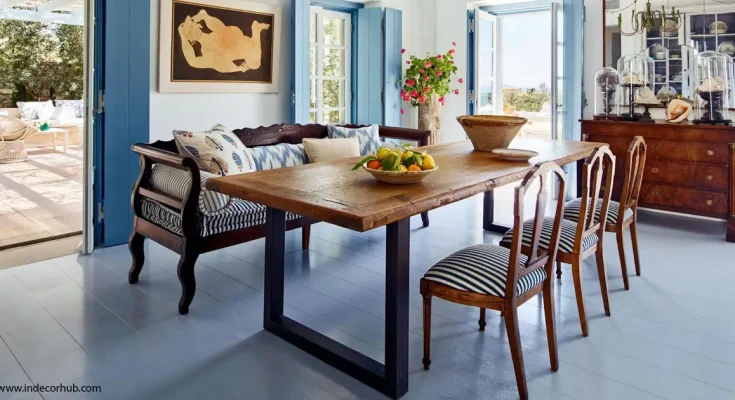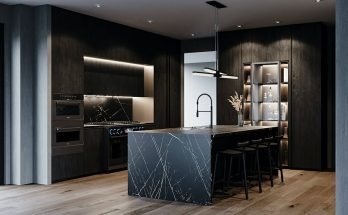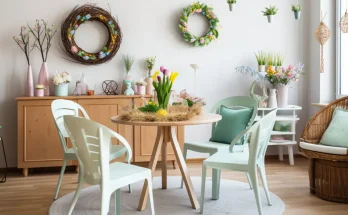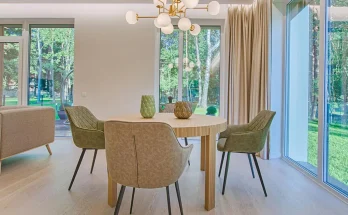Dining tables and chairs do not need to match. Personal style and design preferences guide this choice.
Choosing dining room furniture can be an expression of your unique aesthetic. Many homeowners prefer a coordinated look, opting for matching dining sets to create a harmonious atmosphere. However, mixing and matching tables and chairs has become a popular trend for those looking to add personality and eclectic charm to their dining space.
This approach allows for more creativity and can also be practical; you may find chairs that are more comfortable or a table that fits your space better if you consider them separately. Either way, the key is to create a dining area that resonates with your taste and complements the overall design of your home. Remember, the goal is to create a welcoming space where guests feel at ease and family meals become cherished memories.
Table of Contents
The Evolution Of Dining Room Aesthetics
The dining room has long been a place of gathering, conversation, and culinary enjoyment. Its aesthetic has evolved, transitioning from strict coordination to a playground for personal expression. Exploring the history and modern trends, it’s evident that matchy-matchy furniture sets are no longer the only option.
The Traditional Set: A Historical Perspective
Decades ago, a dining room wasn’t complete without a matching set. The table, chairs, and other furniture pieces were part of a single collection. Elegance and uniformity ruled the space. This approach reflected the era’s social norms—a desire for order and consistency.
Traditional sets signified status. Owning them showed success and taste. Most homes featured identical chair designs, wood finishes, and fabric selections. The coordination spoke volumes of the homeowner’s attention to detail.
Trends Shaping Modern Dining Spaces
Today’s dining room is a tapestry of textures, colors, and styles. Designers now mix and match pieces from different periods and origins, embracing a more eclectic approach. The rise of social media and home décor platforms has fueled this trend, empowering people to be adventurous with their interiors.
- Mismatched chairs add visual interest.
- Bold color palettes breathe life into the space.
- Varied furniture designs reflect personality.
Repurposed and upcycled items are stars in modern dining areas too. They introduce historical depth and uniqueness into the room. Many homeowners enjoy crafting narratives with their furniture, mixing grandma’s heirloom table with contemporary chairs.
Vibrant patterns and innovative materials mark the current trends. Sustainably sourced elements now play a vital role in shaping modern dining rooms. These spaces become a reflection of individual values, like environmental consciousness and artistic freedom.
Design Principles For Harmonious Interiors
Design principles for harmonious interiors play a key role in creating a cohesive and inviting space. When it comes to dining tables and chairs, the question of whether they need to match can baffle many homeowners. The good news? Strict matching isn’t a must. Instead, harmony and balance drive the visual appeal of a dining set. Let’s explore how to pair tables and chairs for a balanced, aesthetically pleasing dining area.
Elements Of Visual Balance
Creating a visually balanced dining room doesn’t require identical furniture pieces. Instead, think about symmetry and proportion. A heavy, rustic table pairs well with sturdier chairs, while a delicate glass table would look better with sleek, minimalist seating. The weight, scale, and form of furniture should complement each other for balance.
- Match heights: Similar chair and table heights maintain a uniform look.
- Vary shapes: Contrast round tables with angular chairs or vice versa.
- Uniform details: Echo the style of table legs in the chair design.
Color Theory In Furniture Pairing
Harmony in interior design often relies on effective color pairing. Color theory can guide the selection process. Here’s how:
| Color Scheme | Description | Application |
| Monochromatic | Uses variations in lightness and saturation of a single color. | Pick chairs in darker or lighter shades of the table color. |
| Analogous | Combines colors that are next to each other on the color wheel. | Pair a blue table with green or violet chairs. |
| Complementary | Joins colors opposite each other on the color wheel. | Match a yellow wood table with purple upholstered chairs. |
Remember, a neutral palette serves as a versatile background for both tables and chairs. Introduce textures and fabrics to add depth without overwhelming the space with color.
The Mix-and-match Philosophy
The Mix-and-Match Philosophy breathes life into dining room décor. It is about breaking free from uniformity. Unique combinations enhance visual interest. They tell a story of personal taste. This fresh approach transforms dining areas into expressive spaces.
Breaking The Matchy-matchy Rule
Traditionally, dining tables and chairs come as a set. Same design. Same material. But times change. Matching sets are not a must. A variation in chairs can be a talking point. It adds character. The contrast between wooden tables and metal chairs can be striking. Think about the texture and color palettes. How do they complement each other? This is the crux of breaking the matchy-matchy rule.
Creative Freedom In Eclectic Styling
Eclectic styling values creative freedom. Mixing vintage chairs with a modern table can be eye-catching. It creates a dialogue between different periods.
Pick chairs with distinct designs. Mix woods, fabrics, and metals. Here are a few tips:
- Choose a color theme for consistency.
- Balance the room with a unifying element.
- Play with chair heights and sizes for dynamism.
Remember, the aim is to create a welcoming space that feels like home.
Functionality Vs. Aesthetics
Functionality vs. Aesthetics: This classic debate often surfaces in interior design. Does the perfect dining space favor practicality or visual harmony? In the quest for both form and function, examining dining tables and chairs reveals a balance is key.
Meeting Practical Dining Needs
Comfort and convenience take the front stage when considering dining furniture. A table must fit the room and provide enough space for diners. Chairs should offer support for lengthy meals. Here’s a checklist to help select practical pieces:
- Measure the dining area for a fitting table size.
- Ensure chairs have ample legroom beneath the table.
- Consider ease of maintenance for both tables and chairs.
Sensory Appeal Of Coordinated Pieces
A matched set can stir emotions and create a visual treat. A harmonizing set elicits a sense of order and sophistication. When pieces blend well, they enhance the dining experience. Here are attributes to consider:
| Attribute | Benefit |
| Color Scheme | Unifies the space and sets the mood. |
| Style Consistency | Delivers a cohesive design statement. |
| Material Unity | Makes cleaning and upkeep easier. |

Material Matters In Dining Set Composition
Imagine a grand dining room, elegant and inviting. The heart of this room often lies in the harmony of its furniture. Material Matters in Dining Set Composition can define the aesthetic and the atmosphere. It also holds the key to whether dining tables and chairs should match. Let’s delve into the choices of materials for a dining set that speaks to both style and comfort.
Matching Woods And Finishes
Unity in design creates a classic, cohesive look. Matching woods and finishes set the stage for a traditional dining space. An oak table beside oak chairs, each piece sharing the same stain, brings warmth and elegance.
| Wood Type | Finish Options |
| Oak | Natural, Honey, Espresso |
| Maple | Cherry Stain, Black Lacquer |
| Walnut | Clear, Dark Chocolate |
Contrasting Textures And Surfaces
Contrasting textures and surfaces create interest and depth. A sleek glass table may pair perfectly with leather chairs. The shiny, smooth tabletop reflects light, while the matte, soft chairs invite guests to sit and relax.
- Glass Table: Light, Modern
- Leather Chairs: Comfortable, Rich Texture
Mixing materials can also highlight quality craftsmanship. Metal table legs with a wood tabletop might be the perfect combination. This mix gives a nod to industrial design while still feeling warm.
- Metal Legs: Durable, Urban Edge
- Wood Top: Classic, Warm
The Role Of Personal Taste
Deciding whether dining tables and chairs should match depends on personal taste. Personal taste shapes our living spaces. It reflects our style, personality, and the comfort we seek at home. The dining room is a personal canvas. On this canvas, you express yourself through colors, shapes, and designs.
Reflecting Your Style In Furniture Choices
Choosing furniture is like picking out clothes. Just as your wardrobe says who you are, so does your furniture. A matching dining set can feel uniform and sleek. A mixed set often looks creative and carefree. There is no right or wrong. Your space showcases who you are.
- Traditional settings often feature matching sets.
- Modern homes may mix pieces for a unique look.
- Rustic styles embrace the character of mismatched furniture.
When To Follow Or Ignore Design ‘Rules’
Design ‘rules’ can guide but not decide. A cohesive look often requires matching pieces. But breaking rules can breathe life into a space. Trust your gut feeling. Embrace experimentation and fun. Below are some tips:
- Consider Room Size: A smaller space might benefit from uniform furniture to seem larger.
- Think About Use: For frequent entertainers, comfort might trump design.
- Personal Preference: At the end of the day, your happiness matters most.
Remember, your dining area is yours to define. Enjoy the process of making it your own.
Space Dynamics And Furniture Selection
Imagine a dining area that breathes elegance without looking cramped. Mixing chairs and tables allows for a unique aesthetic. The right combination enhances the space’s dynamics. Yet, before making a choice, understanding the room’s size and how furniture will fit is crucial. A well-thought-out selection can transform the dining experience.
Size Constraints And Opportunities
Every dining space holds potential. Here’s how to uncover it:
- Measure the space before purchasing to avoid an overcrowded layout.
- Small rooms benefit from round tables and sleek chairs.
- For larger areas, consider extendable tables or bolder chair designs.
| Room Size | Table Shape | Chair Style |
| Compact | Round | Armless |
| Spacious | Rectangle/Oval | With Arms/Larger |
Spaces should dictate furniture scale, not just style. Choose pieces that fit well.
Flow And Movement Around The Table
Consider movement within the dining area:
- Allow for at least 36 inches between the table and walls or other furniture.
- Chairs should slide out smoothly without hitting walls or other objects.
Furniture placement impacts flow. Good flow makes a dining area feel inviting. It facilitates movement and interaction between diners. Chairs with a smaller footprint are perfect for maintaining flow, especially in tighter spaces.
Blending New And Vintage Pieces
The union of new and vintage pieces breathes unique life into dining spaces. Pairing a sleek, modern dining table with vintage chairs creates a bespoke aesthetic. This blend tells a visual story, mixing the warmth of the past with the clean lines of contemporary design. Embrace the design challenge, as the result can be a striking and harmonious space.
The Charm Of Antiques With Modern Flair
Vintage chairs around a modern table serve as a conversation piece. This juxtaposition elevates the dining room décor. Antique charm meets modern simplicity for a look that stands out. Aim for a cohesive color scheme or material that ties the pieces together. This strategy ensures the mix appears intentional and stylish.
Restoration And Reupholstery Considerations
When merging old and new, inspect antiques for necessary restorations. Structural integrity is key for safety and comfort. Look for signs of weakness or damage. Address these issues to preserve the chair’s use for years to come.
- Assess the stability of chair frames
- Check for signs of wood rot or pest damage
- Identify any loose joints or missing hardware
Consider reupholstering to match the table or room’s color palette. The quality fabric reflects the chair’s era while adding modern touches. Use padding that offers comfort and resilience. Below is a simple table to help decide on fabric choices.
| Antique Era | Fabric Type | Color Considerations |
| Victorian | Velvet, Tapestry | Rich, Deep Tones |
| Mid-Century | Wool, Tweed | Bold Patterns, Earthy Tones |
| Art Deco | Leather, Satin | Metallics, Geometric Patterns |
Coordination Techniques For Cohesive Looks
A dining room where every piece harmoniously fits together invites both comfort and style. Yet, the question arises – do dining tables and chairs need to match perfectly? Not necessarily. With smart coordination techniques, a cohesive look is not only possible but also an avenue for creative expression.
Accessorizing To Tie In Dissimilar Elements
Accessorizing does more than add flair. It unites disparate pieces within your dining space. Consider these:
- Table Runners: A runner can bridge the style gap between your table and chairs.
- Seat Cushions: Cushions in a color that echoes your table’s tone bring uniformity.
- Centerpieces: A striking centerpiece makes the table the focal point, easing clashes.
Using Patterns And Solids Effectively
Balance is key in mixing patterns and solids. Here’s how to keep it in check:
| Pattern | Solids |
| Patterned Chairs | Solid Table |
| Patterned Tablecloth | Solid Chairs |
Pick a dominant color in the pattern. Use it in solid pieces for a united look.
Impact Of Mismatched Furniture On Resale Value
When it’s time to sell furniture, the question arises: do dining tables and chairs need to match to maximize resale value? The answer isn’t straightforward. Mismatched furniture can influence potential buyers differently. Some may see unique charm, while others prefer cohesive matching sets.
Perception Of Value In Matching Sets
Matching dining sets can often convey a sense of uniformity and intentionality in design. This can translate into a higher perceived value during resale:
- Sense of Completeness: A matching set appears complete and ready for immediate use.
- Reduced Effort for Buyer: No need to find additional pieces to complete the set.
- Classic Appeal: Timeless designs tend to match and remain popular over time.
Appeal Of Unique, Non-conforming Pieces
On the flip side, unique, mismatched dining sets can attract a different kind of buyer:
- Individualistic Style: Showcases a personalized touch that may resonate with certain buyers.
- Eclectic Mix: Appeals to those looking for a break from traditional styles.
- Potential for Upcycling: Buyers interested in DIY may value the potential to customize mismatched pieces.

Consistency Across Home Décor
The idea of a cohesive interior design often sparks debate. Should dining tables and chairs match? Recent trends suggest not necessarily. A consistent home décor theme helps tie spaces together. Yet, diversity in furniture can add character. This balance enhances a home’s aesthetic appeal.
Carrying Themes Beyond The Dining Area
Dining rooms often serve as focal points in homes. The design choices made here can influence the décor throughout your living space. A theme carrying beyond the dining area ensures a fluid sense of style.
- Color Palettes: Use similar colors throughout your home to create harmony.
- Material Continuity: Echo materials like wood or metal in other rooms.
- Design Motifs: Repeat patterns or shapes to connect different spaces.
These elements help blend areas without exact matches in furniture.
Balancing Uniformity With Diversity
A balance between uniformity and diversity can create a dynamic interior. Uniformity offers a calming place for the eye to rest. Diversity brings energy and interest.
| Uniformity | Diversity |
| Matching wood finishes | Varying chair styles |
| Consistent fabric textures | Complementary color accents |
| Uniform lighting fixtures | Unique decorative pieces |
Select a few areas to maintain consistency. Then, add diverse elements to make each room stand out. Your dining set does not have to match perfectly. Allow your creative side to guide the design for a captivating look.
Expert Opinions And Design Case Studies
Deciding whether dining tables and chairs should match shapes many dining room designs. This choice can reveal the room’s character. Expert opinions and design case studies help clarify this decision. They show how both matching and mismatched sets can create stunning spaces.
Insights From Interior Designers
Top interior designers often share their thoughts on dining set coordination. They focus on blending function and style. Balance is key. Designers emphasize that matching sets can give a classic, cohesive look. Yet, mismatched pieces can add personality and uniqueness to a room.
- Contrast and Harmony: Many designers suggest that contrast can be as harmonious as matching sets.
- Color Palette: They advise keeping a consistent color palette even when mixing designs.
- Proportion Balance: Attention to scale and proportion ensures that mismatched items look intentional, not haphazard.
Real-life Examples Of Matching Vs. Mismatched Sets
Seeing is believing. Real-life examples show how both approaches can succeed.
| Room Type | Matching Set | Mismatched Set |
| Traditional Dining Room | Elegance with a seamless look. | Classic table with modern chairs. |
| Modern Dining Space | Sleek, minimalist design. | A pop of color with different chair styles. |
Case studies often showcase eclectic blends. A popular combination includes a rustic table with chic chairs. This creates a warm, inviting atmosphere. Transitional spaces may blend old and new. This results in a rich, layered aesthetic.
Frequently Asked Questions Do Dining Tables And Chairs Need To Match?
Do Dining Chairs Have To Match Dining Table?
Dining chairs do not need to match the dining table. Mixing styles can add personality and visual interest to your dining space. Choose chairs that complement the table’s design and color scheme for a cohesive look.
How Do You Mix And Match Dining Tables And Chairs?
To mix and match dining tables and chairs, focus on scale and proportion. Select chairs that contrast with the table’s style, such as rustic with modern. Ensure the seat heights are compatible. Choose a unifying color or material, and balance it with complementary textures for visual harmony.
Are Mismatched Dining Chairs In Style?
Mismatched dining chairs are currently a popular trend, offering an eclectic and personalized touch to home décor.
Conclusion
Wrapping up, the need for matching dining sets depends on your personal style and room aesthetic. Embrace a coordinated look or mix for an eclectic vibe – the choice is yours. Remember, a thoughtful arrangement that reflects your taste makes your dining space uniquely welcoming.



